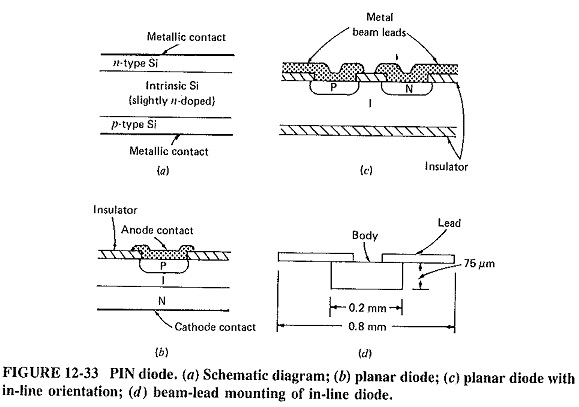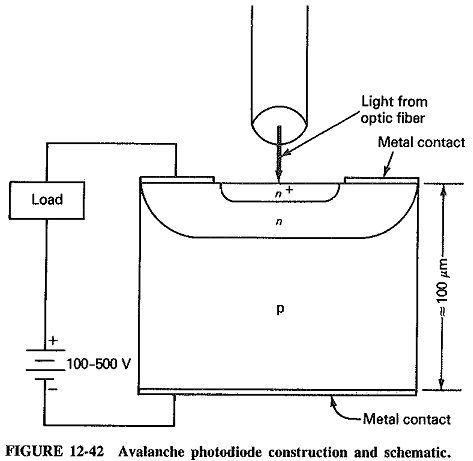Types of Optoelectronic Devices:
Although light-emitting diodes and photodiodes are not quantum-mechanical devices in the Types of Optoelectronic Devices, they are semiconductor devices closely associated with lasers. It is most convenient to cover them here.
Light Emitting Diodes (LEDs):
The construction of an LED is similar to that of a laser diode, as indeed is the operational mechanism. Once again electrons and holes are injected across heterojunctions, and light energy is given off during recombination. The materials used are the same as for the corresponding laser diodes, but the structure is simpler, there are no polished ends and laser action does not take place. Consequently, power output is lower (perhaps one-twentieth) than for the laser, a much wider beam of light results and the light itself is no longer monochromatic. A small lens is often used to couple the output of the LED to the optic fiber.
Despite the foregoing, the LED does have a number of advantages over the laser. For example, it is a good deal cheaper and tends to be more reliable. Moreover, the LED, unlike the laser, is not temperature-sensitive, so that it can operate over a large temperature range without the need for elaborate temperature control circuits which the laser may require. In practice, lasers tend to be used in a fairly large proportion of practical systems, especially the more exacting ones, noting that pulse modulation is normally used, and the light output of lasers can be pulsed at much higher rates than that of LEDs
Photodiodes:
Other Types of Optoelectronic Devices is a PIN diode, such as any of the ones shown in Figure 12-33, is capable of acting as a photodiode. If a large reverse bias, of the order of 20 V or more, is applied to such a diode, no current will flow. However, if the diode absorbs light quanta through a window on the p side, each quantum will cause an electron-hole pair to be created in the intrinsic depletion layer, and a corresponding current will flow in the external circuit. Within limits, this current will be proportional to the intensity of the impinging light, so that photo-detection is taking place.
The original photodiode semiconductor was germanium, and it is still used for wavelengths in excess of about 1.1 μm; for shorter wavelengths silicon is preferred. Because of the well-known sensitivity of germanium to temperature, research is currently taking place among the newer semiconductor materials, such as GaAlAs and InGaAs, to find a replacement for the germanium PIN photodetector.
Avalanche Photodiodes (APDs):
A problem with the PIN photodiode is that it is not overly sensitive; no gain takes place in the device, in that a single photon cannot create more than one hole-electron pair. This problem is overcome by the use of the avalanche photodiode, which, in some respects, operates in a manner similar to the IMPATT diode.
An APD, such as the one shown in Figure 12-42, is operated with a reverse voltage close to break-down. Like the IMPATT, the APD is capable of withstanding sustained break-down. As in the PIN photodetector, a light quantum impinging on the diode will cause a hole-electron pair to be created, but this time avalanche multiplication can take place, as in the IMPATT, so that the initial electron-hole pair will cause several others to be created, with consequently increased current flowing through the eternal circuit. The extent of avalanche multiplication can be gauged from the fact that a typical APD is 10 to 150 times more sensitive than a PIN photodetector.
The materials used for APDs are the same as for the corresponding PIN diodes. Because the voltage gradient across the APD is so high, electron and hole drift is higher than for the PIN diode, and the response time is similarly faster, typically 2 nS compared with 5 nS for the PIN diode. It follows that the APD can be used for higher pulse modulation rates than the PIN. There is a fairly close correlation between light transmitters and receivers in fiber-optic systems. Those less exacting systems which use LEDs for transmission are also likely to use PIN photodiodes for reception. The systems requiring higher sensitivities and higher modulation bit rates are likely to use lasers for transmission and avalanche photodiodes for reception.

